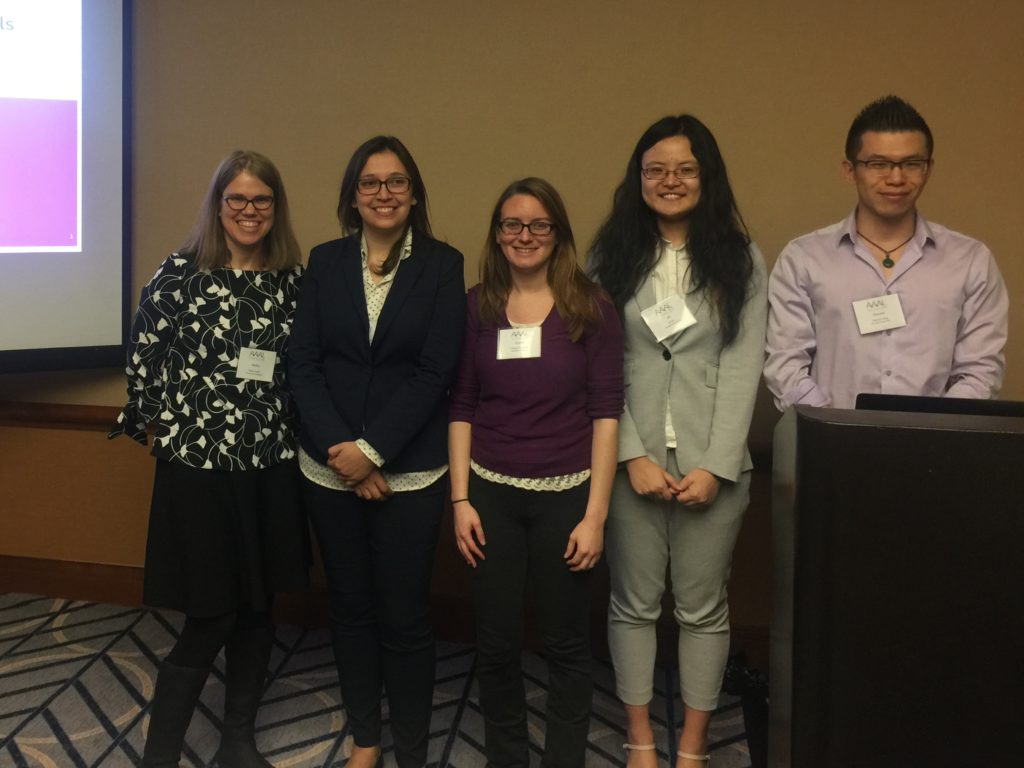Promoting citation research at AAAL 2018
Researchers from the Crow team presented “Citation practices of L2 writers in first-year writing courses: form, function, and connection with pedagogical materials” at AAAL 2018. The presenters were Wendy Jie Gao, Lindsey Macdonald, Zhaozhe Wang, Adriana Picoral and Dr. Shelley Staples.

Abstract
Citation practices and styles are integral to academic writing contexts. Previous research on citation use has focused on variability across citation form (e.g., integral/non-integral) and function (e.g., synthesis/summary) (Charles, 2006; Petric, 2007; Swales, 2014). However, most studies have focused on advanced L1 English student and professional writing. In addition, no studies to date have investigated the influence of instructor materials on students’ citation practices. Using a corpus of L2 writing, we examined (1) how the L2 writers’ citations vary in form and function across different assignments and instructors; (2) how students’ citation practices might be influenced by the pedagogical materials provided for each assignment.
Our corpus includes 74 papers (72,395 words) across two assignments, a literature review (LR) and a research paper (RP), from a first-year writing course for L2 writers. We calculated the number of citations and references in each assignment (per 1,000 words), and coded citations for integral, non-integral or hybrid (integral and non-integral) forms. We then coded citation functions based on Petric (2007) and qualitatively examined the relationship of the writing to pedagogical materials, such as the number of sources required and the form and function of citations in sample papers.
Our preliminary results show that the writers most frequently use integral citations with little synthesizing function. While there is a large variation in the number of citations both within assignments and across instructors (LR: 3.54-9.73, RP: 5.25-7.05), the number of references is more consistent in the literature review (LR: 2.66-3.27, RP: 3.72-4.88). Students prefer a citation style of non-quote to quote. Integral citation is more frequently used in the literature review, while non-integral citation appears more in the research paper. Hybrid citation form is consistently in existence almost across all sections. These results might be attributed to instructors’ use of model literature review papers that almost exclusively feature integral citations, as well as explicit requirements (3 sources) in the assignment sheets. Attribution only is the largest category for rhetorical functions of all the citations. In addition, students’ awareness of establishing links between sources and making statement of use seem to have been influenced by sample papers. Our findings show the potential need for more instruction on the use of sources for synthesizing information, and the important influence of pedagogical materials.
Citation project conference handout (PDF).
Selected References
Charles, M. (2006). Phraseological patterns in reporting clauses used in citation: A corpus-based study of theses in two disciplines. English for Specific Purposes, 25(3), 310–331. doi:10.1016/j.esp.2005.053
Lee, J. J., Hitchcock, C. & Casal, J. E., (2018), Citation practices of L2 university students in first-year writing: Form, function and stance. English for Specific Purposes, 33, 1-11. https://doi.org/10.1016/j.jeap.2018.01.001
Petrić, B. (2007). Rhetorical functions of citations in high- and low-rated master’s theses. Journal of English for Academic Purposes, 6(3), 238-253.
Swales, J. (2014). Variation in citational practice in a corpus of student biology papers from parenthetical plonking to intertextual storytelling. Written Communication, 31(1), 118–141. doi:10.1177/0741088313515166

Leave a Reply
You must be logged in to post a comment.